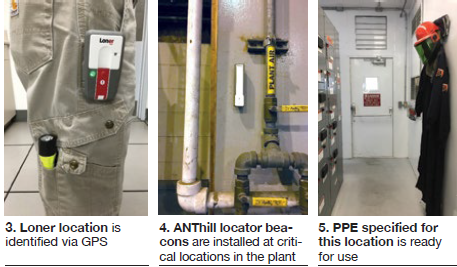Chlorinator conversion from bleach

Challenge. Government limits on Orlando Cogen’s wastewater discharge permit for sodium was reduced by half. Discharge sodium levels exceeded the new limits; sodium hypochlorite was added continuously for biological control in the cooling tower, which relies on blowdown to the city sewer for conductivity control.
To meet the new requirements, batch addition of sodium hypochlorite was implemented on a twice-per-day regimen. This barely got the facility’s sodium discharge level under the new permit limit.
Plus, biological growth in the cooling tower could not be controlled with the new program. In only weeks, biological growth formed on the cooling-tower structure and fouled packing and fill material (Fig 1). Besides the obvious biological growth, bulk handling of liquid sodium hypochlorite was required monthly, the hazards of which required PPE of chemical suits, goggles, face shields, gloves, and boots.
The highly corrosive characteristics of sodium hypochlorite also caused numerous process equipment failures in piping, valves, and the injection pump.

Solution. Industrial-grade calcium hypochlorite in tablet form, which is used in the food-processing industry, was used in a chlorinator vessel along with a solenoid valve wired to an ORP controller. The latter opened and closed the solenoid valve, based on control-band set points for free chlorine level, allowing a slip stream of tower water to flow through the chlorinator dissolving the tablets. This process allowed continuous control.
Results. A 40% to 50% reduction in sodium discharged was achieved using the calcium hypochlorite tablets. Complete biological control throughout the cooling tower was achieved within a few weeks (Fig 2).
The chlorinator process consists of only one moving part, the solenoid valve. The maintenance on this process has been reduced to practically zero with the exception of an annual cleaning of the chlorinator vessel, which takes only about five minutes to do.
The cost of calcium hypochlorite tablets to maintain proper chlorine levels in the tower water is less than the cost of bulk sodium hypochlorite.
Finally, onsite handling and storage of liquid sodium hypochlorite is no longer required. Safe handling of calcium hypochlorite requires only gloves when filling the chlorinator daily.
Project participant: James Chaney
Man down: Lone worker emergency response
Challenge. Minimize risk exposure, improve monitoring capability, and reduce response time for single-operator shift operations. As with many facilities, the operating staff is composed of an ageing workforce with associated limitations and concerns, further amplifying the need for these improvements.
Solution. Risk: Plant policies were established, restricting potentially hazardous evolutions to normal working hours when support staff is available for assistance. Operator rounds were evaluated, readings in remote locations were satisfied using alternative methods—such as video—or eliminated.
Monitoring: The original man-down system consisted of a traditional check-in system with limited versatility, potentially poor response time, and was considered a nuisance by operators. A new system from Blackline Safety Corp was implemented. It consists of Loner monitoring devices (Fig 3), ANThill locator beacons (Fig 4), and a remote monitoring service.

The versatile Loner devices provide four modes of initiation: manual, fall detection, no motion, and silent alert. Tracking of Loner location is accomplished through GPS when outside and through ANThill locator beacons staged in each building when inside.
Response: Loner initiation results in immediate direct voice communications with the Blackline Safety monitoring service. The monitoring service follows a user-defined escalation protocol to attempt resolution prior to requesting emergency response, if possible. If emergency response is requested, the monitoring service provides responders with operator location and facility access information.
Results. No actual emergencies have occurred since the system was placed in service. A few accidental initiations have resulted in immediate response and resolution at the plant level. The system is tested quarterly and has performed flawlessly.
Project participant: Tim George
Arc-flash procedures made easy
Challenge. Implement an easy-to-understand arc-flash safety program and improve compliance with the requirements of OSHA 1910.269, “Arc Flash Safety for Utilities,” and NFPA 70E, “Standard for Electrical Safety in the Workplace.”
Solution. Training and qualification: All operators were trained on the basic requirements of electrical safety and completed arc-flash specific training through NFPA 70E online courses. All routine electrical operations were identified, and detailed procedures were created for each. These procedures establish the standard requirements for the performance of each task and eliminate the need for additional assessment and permitting.
Operator proficiency was established for each of the procedures. All operators are now qualified to perform only those evolutions, and only if no abnormal conditions exist. Any evolution outside of their qualification boundaries requires additional evaluation and permitting.
Arc-flash assessment: Safety Tracker software from EasyPower was selected based on its flexibility and ease of use. Many short-circuit analysis programs provide the end user with only fixed data tables from which information is obtained to create labeling and permitting.
Safety Tracker provides a fully customizable one-line diagram allowing user manipulation of electrical plant configuration, allowing for real-condition arc-flash data. Bus- and task-specific energized electrical work permits with associated shock and arc-flash hazard information can be generated, as well as planning/briefing worksheets and custom arc-flash labeling.
Arc-flash PPE: Each power distribution center is staged with the latest lightweight arc flash gear available, with multiple sizes to support all operators. The arc-flash protection rating of staged PPE is sufficient to cover all routine electrical operations in that respective power distribution center (Fig 5).
Results. The training and qualification program has defined the evolutions that operators can perform, eliminating the permit decision-making process. The Safety Tracker software’s flexibility has enabled some evolutions to be performed under reduced arc-flash hazard conditions and significantly improved permitting and labeling. Staging the PPE has made it as convenient as possible for the operators to don proper arc-flash protection for the evolution and minimized the need to interpret labels and make PPE determinations.
Project participant: Tim George
Orlando Cogeneration Ltd
Owned by Northern Star Generation Services
Operated by Consolidated Asset Management Services
120-MW, dual-fuel, 1 × 1 combined-cycle cogeneration facility located in Orlando, Fla.
Plant manager: Jim Murray


